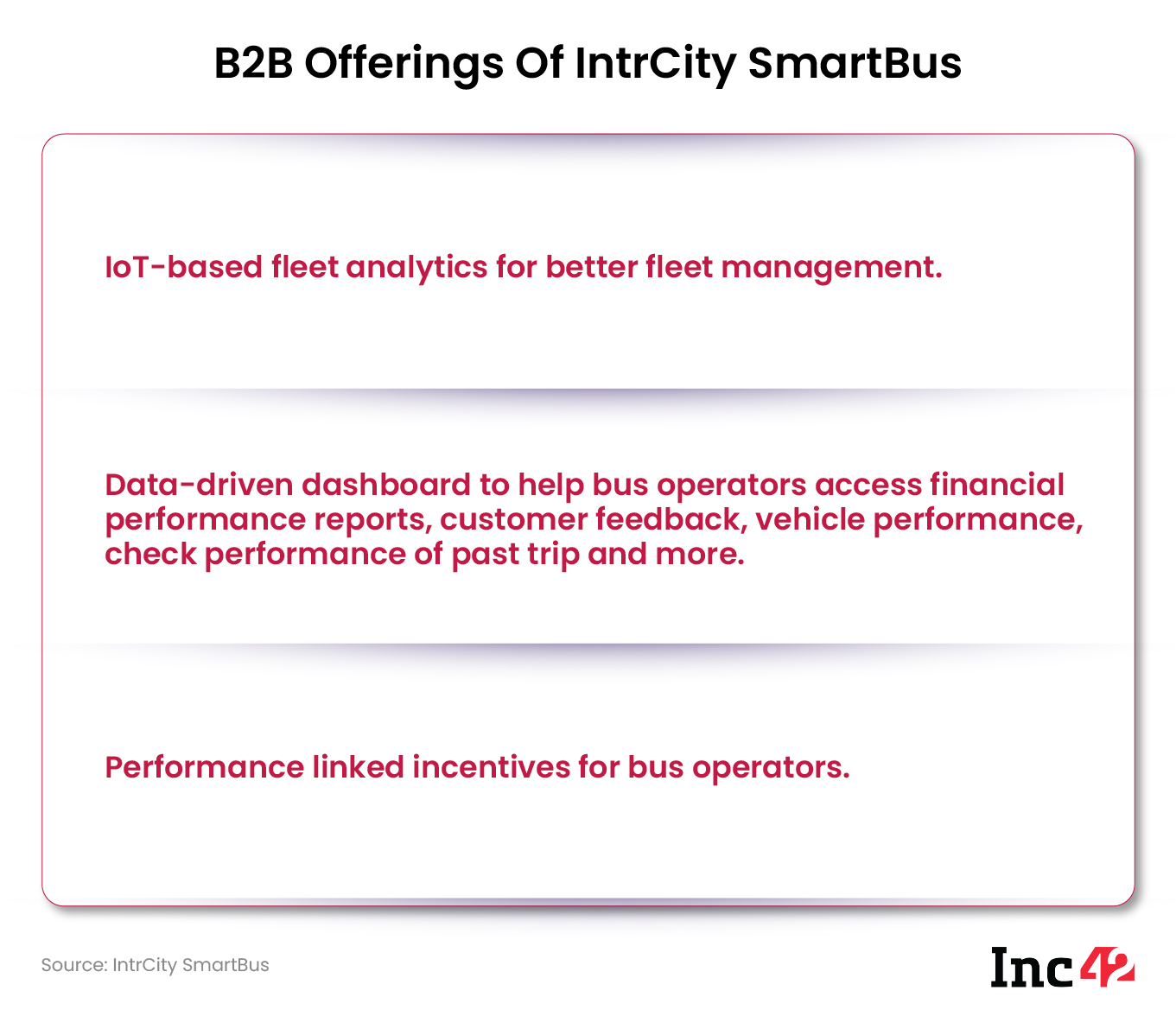The mobility platform offers seamless travel experience to commuters and a steady stream of bookings, better margins and cost efficiency to private bus operators
It claims to have served more than 1 Mn travellers across 700+ cities and 50+ routes since its inception
The platform currently has 200+ buses and has plans to have 500+ buses by the end of FY23
Once upon a time in India, dusty, rusty but time-honoured buses used to ferry people from big cities to nano villages where railway tracks were rare and runways were unheard of.
Despite the rattle and the discomfort, they are still the chosen mode of transportation for intercity travel, especially for journeys under 1,000 KM, according to PGA Labs’ Intercity Travel Mobility Market Report. After all, there are few affordable alternatives even now.
But those road trips are changing over the years. A recent survey by mobility platform IntrCity SmartBus stated that the top preferences of intercity bus travellers in India are hygiene and safety. According to the survey, 65% of Indian bus travellers prioritise travelling with on-board washroom facility while 60% prefer GPS tracking enabled buses.
However, the bus industry has not quite evolved with time or kept up with the travellers’ growing expectations. This is because the bus mobility sector is largely dominated by unorganised players and has seen limited technology adoption.
According to a report by the business research firm PGA Labs, out of the 265K private bus operators in India in FY20, more than 195K (60%) belonged to the unorganised category.
Realising the need for digitalisation to ramp up safety and comfort during long-distance travel, Kapil Raizada and Manish Rathi launched IntrCity SmartBus in 2019. The duo aimed to offer standardised, snug and secure bus rides to commuters while providing India’s private bus operators with a steady stream of bookings, better margins and cost-efficient operations.
IntrCity has built a centralised system with a cloud-connected proprietary technology stack to organise bus travel and created two interfaces – one for commuters and the other for bus operators.
Every SmartBus is equipped with an IoT-powered connected device that offers various features, including real-time bus tracking and vehicle route monitoring and access to vehicle and driver performance data.
The mobility startup began its journey on the Delhi-Lucknow-Delhi route and has grown its business multifold in the following three years. Currently, it serves more than 2 Lakh travellers every month and claims to have a 60% repeat customer rate.
According to Raizada, IntrCity has onboarded more than 50 bus operators and has 225 branded buses operating across 700 cities and 50+ routes. It also clocked an ARR (average revenue rate) of $45 Mn and grew nearly 2X between November 2021 and May 2022.

Marrying Tech With Data For Top-Tier Performance
Before we get into IntrCity’s smart navigation system or what has made it a top-rung player, here is a quick look at the company’s backstory. Long before venturing into bus travel, Raizada and Rathi set up an AI-driven train booking platform called RailYatri (under IntrCity) in 2011.
In an earlier conversation with Inc42, Raizada revealed that the mobility startup combined rich data sets related to intercity travel with its capability to build large tech platforms. The goal was to create a RailYatri-like centralised system to connect long-distance buses and develop a standardised travel experience by analysing commuters’ requirements.
In simple terms, IntrCity SmartBus is a full-stack mobility platform that builds the need-service matrix with the help of cutting-edge tech and data insights. Furthermore, it runs on an asset-light bus aggregator model to stay sustainable despite an unprecedented health crisis.
Overall, the platform has managed to navigate the critical juncture where the new normal mandates streamlined operations and demands unique value creation for all stakeholders across the ecosystem (read bus operators, drivers, travel agents and travellers).
“Our operating system and exceptional travel experience have helped us achieve a 59% NPS (net promotor’s score) and establish reliability and trust in intercity bus services,” said Raizada.

Tech Drives Revenue For Intercity Bus Operators
“We aim to change the entire intercity mobility ecosystem for the traditional small and medium-sized bus operators. Our data and smart systems help operators evaluate vehicle performance and determine operational efficiency on the route taken,” said Raizada.
According to him, the primary challenge for most Indian bus operators is sustaining operational expenses and EMIs throughout the year, including lean seasons. So, IntrCity has in place an induction and training programme to help people understand the benefits of technology and travel experience.
“Early benefits primarily drive tech adoption, and bus operators realise this when they see improved demand and better margins,” he said. This has also helped the startup onboard more operators.
Then there is the revenue benefit. As the technology-driven platform enables route optimisation and has standard protocols for pit stops (the aim is to get the vehicle back into top condition at the earliest to avoid depreciation), operating costs can be reduced by 10-15%, the company claims.
“The average monthly revenue varies based on routes and trips and can be anywhere between INR 7-15 Lakh per bus. We help operators generate 15–25% more revenue on the same route,” said Raizada.
As the brand primarily targets young and tech-savvy travellers (students and young professionals) who are comfortable with online booking, it can further help bus operators to move from offline to online revenue generation.
“We help small and medium operators minimise cash collection losses by preventing freeloaders from occupying seats without paying. As every SmartBus staff has to register all passengers on the crew app, it becomes easy to spot a person who has not booked a seat,” said Raizada.
Finally, they can save money due to efficient operations, better vehicle maintenance and improved driver performance. This may result in higher resale value if one decides to sell the vehicle after three to five years of intercity operations.
As for IntrCity SmartBus, the mobility platform earns its revenue from ticket bookings (on its consumer-facing app), operators get paid a fixed rental per bus per day, besides a profit share as additional income.
“Once rebranded under SmartBus’ name, the buses are on the IntrCity route. Profit sharing post the break-even points is 50:50 between the company and the operator,” disclosed Raizada.
Private Players Pepping Up The Game
Taking the bus for a Greyhound-like cross-country journey (minus the comfort) was not a welcome option until private players took note of the tech and utility shortage in this space and decided to disrupt it with a plethora of techvantages to meet the needs of new-age consumers.
Consider IntrCity SmartBus and its ilk, bus aggregators like Zingbus, redBus.in, ixigo-backed gogoBus and more. All of them are helping the largely fragmented private bus operators enhance their visibility, streamline operations and leverage critical customer data to improve performance.
But it is also worth noting that these players are increasingly looking to reinvent intercity bus travel to stand out from the rest. For instance, Delhi-NCR-based IntrCity SmartBus has come up with several boarding lounges in cities like Ahmedabad, Hyderabad and Chennai for ease of travel, while its branded buses are equipped with AC, free Wi-Fi, CCTVs and washrooms. Who would have thought long-distance bus services could be this cool?
Talking about IntrCity’s short-term plans, Raizada said that the platform would aim to hit $100 Mn in revenue and a high EBITDA margin in FY23.
“To accelerate growth, we intend to extend our services across India by onboarding 100+ operators and having 500+ buses by the end of the current financial year,” he added.
In the next five years, the mobility startup plans to convert 5,000+ regular buses into branded vehicles and cover more than 1,500 cities across 200 service routes.
According to data from PGA Labs, India’s outstation bus market stood at $30.3 Bn in FY20 and is estimated to reach $48 Bn by FY25. On the other hand, the online ticket booking market for private outstation bus travel is estimated to reach $3.6 Bn in FY25 from $1.2 Bn in FY20, growing at a CAGR of 31%.
This indicates the likely impact of private players in this space and how their innovative intervention can transform the historically laggard bus travel ecosystem. It is time to wait and watch whether tech-driven platforms like IntrCity SmartBus can really usher in a transportation success story.









